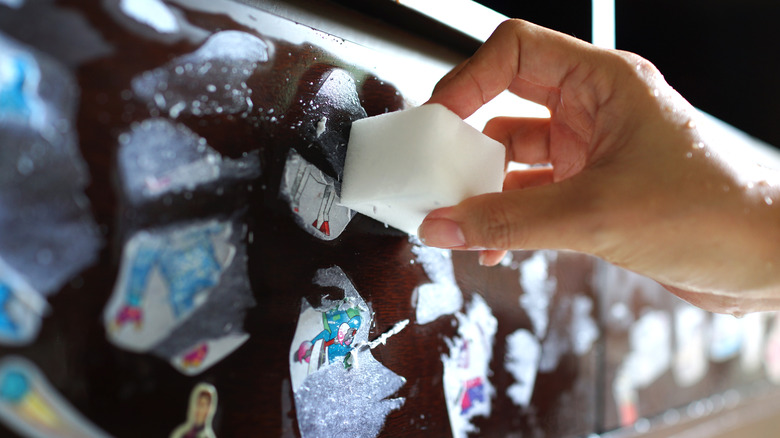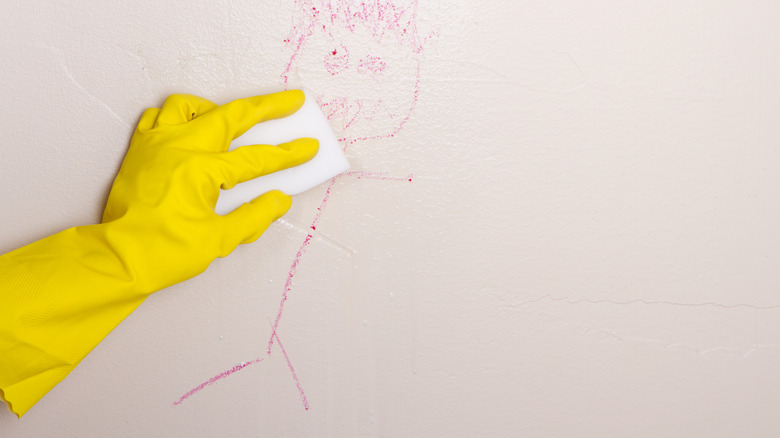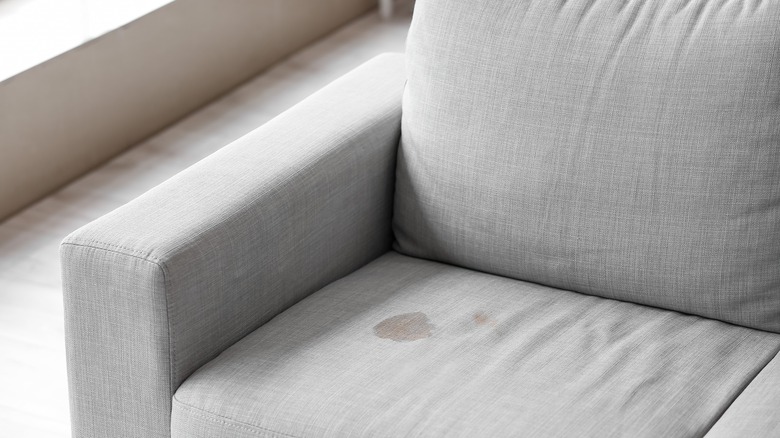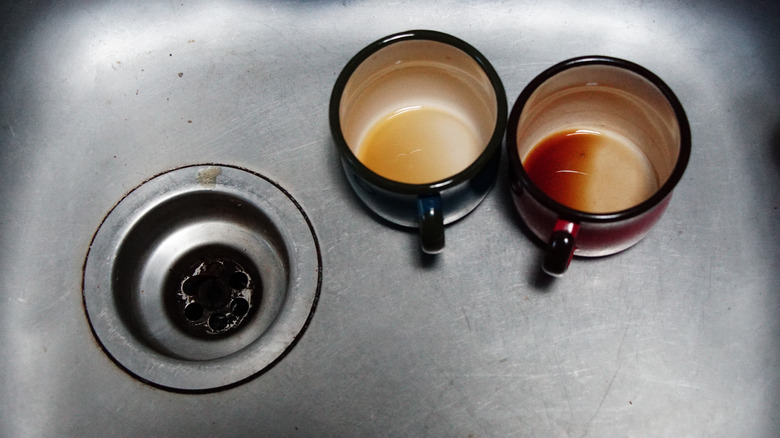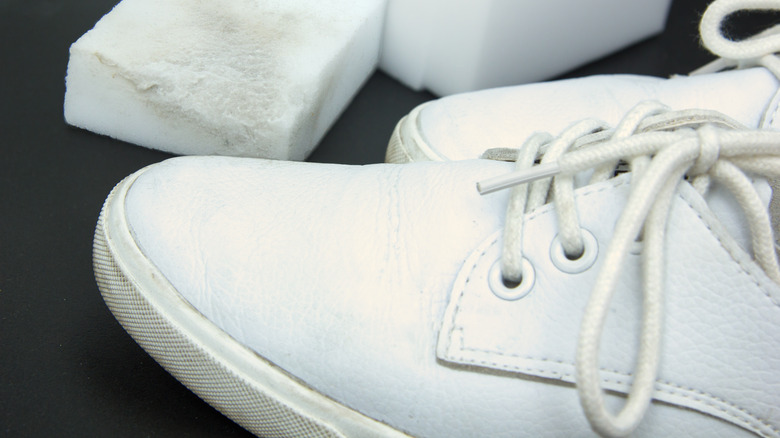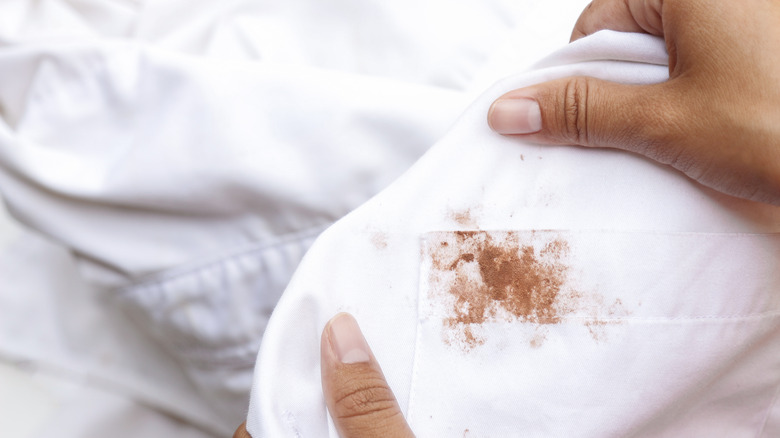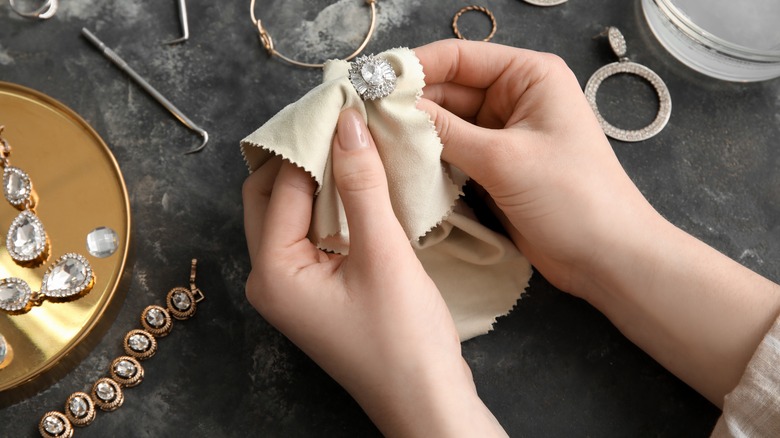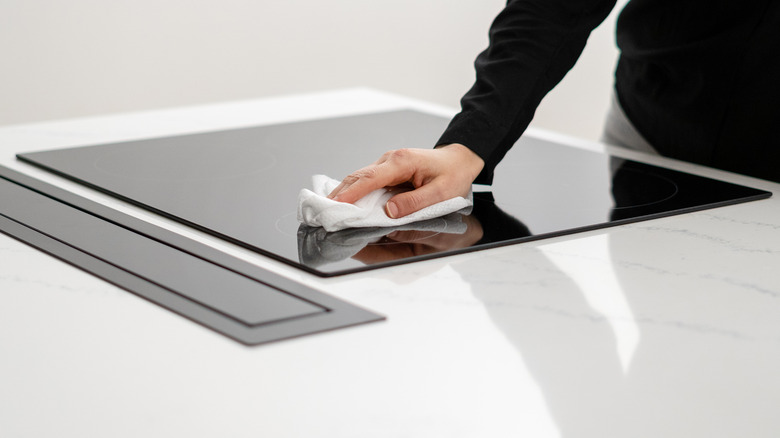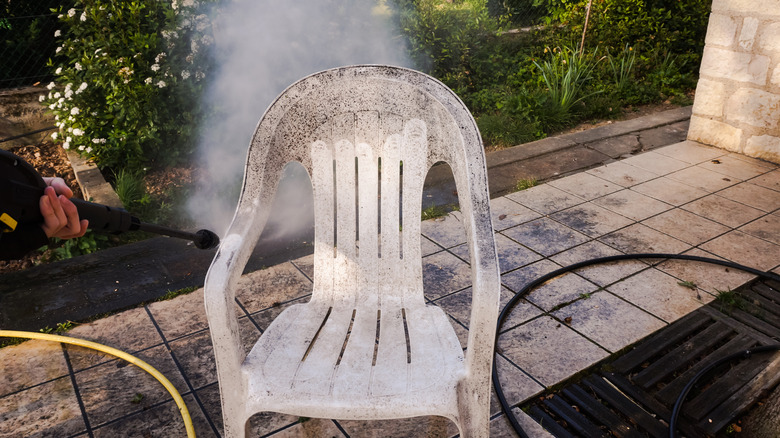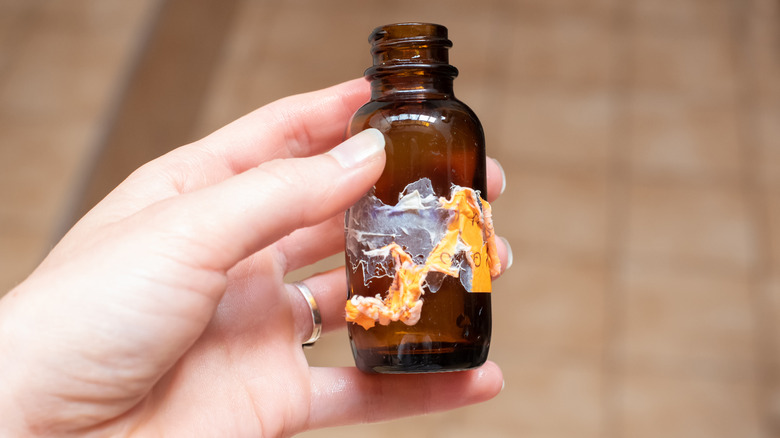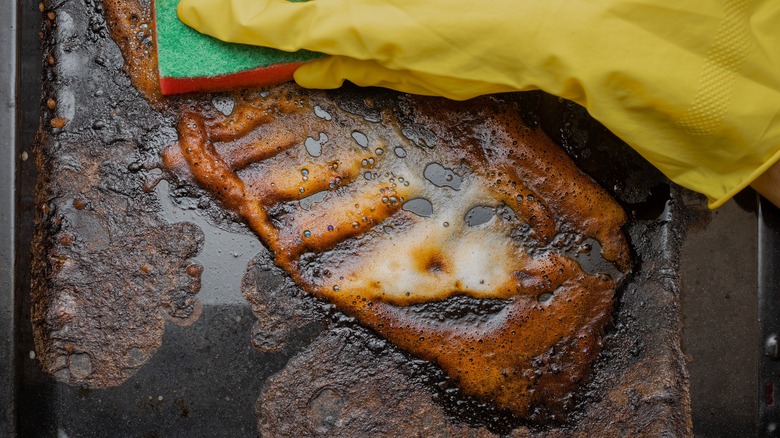Things You Didn't Know You Could Do With A Mr. Clean Magic Eraser
You've most likely used a Mr. Clean Magic Eraser to help you tackle various projects around the house, from scuffs on the wall to dirty countertops, but there are a ton more things you can use it for to simplify your cleaning routine. Made out of dense melamine foam, it uses a micro-abrasive texture that gently but effectively strips grime, residues, and stains from a host of surfaces without harsh chemicals.
But did you know that the sponges also work well to help you get rid of burnt-on gunk from bakeware, lift stains from clothing, or make your shoes look like new? They'll help you save time and avoid the hassle of breaking out the harsh chemicals to get your items clean. In turn, this can make your belongings last longer and encourage you to use a safer, chemical-free cleaning approach, which is important if you're trying to be more eco-friendly.
Exploring these unique uses will help you understand the potential they offer. Whether you want to brighten your dingy jewelry or remove your kid's permanent marker art from your walls, the Magic Eraser allows you to do so. You'll get a multi-use solution to solve a range of problems you had no idea the eraser could solve, helping you clean smarter and more efficiently.
Removing permanent marker from walls
Folks have long used Magic Erasers to tackle crayon drawings and odd scuff marks on walls, but they're also great for removing permanent marker stains. The super-fine fibers in the foam get into the textures or grooves that traditional cleaning cloths can't reach, making the eraser a handy ally in your fight for a clean home.
To remove the permanent marker from the walls, slightly wet the sponge with tap water. Gently work the sponge over the stained spot using a circular motion. Don't scrub too hard because you want to remove only the marker, not the paint, and the Magic Eraser is strong enough to fade or remove it altogether. This is especially true for walls with a flat or matte finish because harsh scrubbing can pull the paint off and make the spots even more noticeable. Once the mark lifts, use a clean, damp cloth and wipe any residue off before leaving the area to dry. The abrasive nature of Magic Erasers makes it very easy to remove more than the marker spots accidentally. So, test the eraser on a small area before tackling more prominent marker stains.
Lift dirt and grime from microfiber couches
Even though there are several ways to successfully clean your microfiber couch, with a Magic Eraser, you can scrub deep into the fabric's texture to reach stains that regular cloths or brushes miss, making it look cleaner.
Check the label before you use a Magic Eraser to clean your couch. If it's an acceptable cleaning agent, dampen the eraser and work with gentle, light strokes over grimy spots. Continue this process until the dirt lifts, then wipe the sofa with a clean, damp cloth to remove the melamine residue. Finish by letting the couch dry before sitting on it to avoid dirt immediately re-collecting on the wet spots. However, be aware that Magic Erasers are abrasive and can potentially damage your couch by causing fraying or pilling by too much friction when scrubbing. Be sure to test on a small area of the couch before you tackle the stains.
Remove coffee stains from mugs
The Magic Eraser allows you to remove coffee stains from mugs with its micro-abrasion qualities. The sponge strips out the coffee deposits with just water and physical pressure, making it a good alternative if you're sensitive to cleaners or want a more eco-friendly cleaning method.
To remove coffee deposits on your favorite mugs, dip your Magic Eraser into water to get it damp, and gently scrub at the stains in a circular motion until they fade. Rinse the mug to remove lingering residues and dry it with a dish towel. The biggest caution with this process is the abrasive nature of the sponge. It's safe to use on things like porcelain and ceramic, but applying too much pressure can scratch the surface. Also, if you have painted or decorated mugs, you can fade the design. This is why you always test on a small area and work slowly to ensure you only remove the stain.
Scrub grime to brighten shoes
One of the best ways to keep your white shoes looking like new is to regularly spot-clean them with a Magic Eraser. It's a powerful tool for getting rid of the dirt, grime, and scuffs that build up on and age your footwear. The finely abrasive texture will scrub dirt deposits and scuffs without the need for chemicals when wanting to minimize evidence of wear and tear.
Dip the eraser in water to saturate it and squeeze out the excess water to avoid making a mess. Gently scrub the dirty areas around the soles with the eraser, increasing to moderate pressure if the shoes are extra dirty. Take your time and work slowly instead of applying too much pressure, which can accidentally damage the shoe's material. Wipe the cleaned areas using a damp cloth to remove any residue and allow them to dry before wearing.
Lift stains from clothing
The Magic Eraser's structure makes it gentle enough to clean a range of surfaces while taking out seemingly impermeable stains, including stains on clothing. You can use the sponge to eliminate wine, grass, and ink stains that other detergents can't. As you scrub, the sponge physically breaks down the stain's compounds, allowing you to pull them from the fibers without needing bleach or other strong chemicals. The untold truth about Magic Erasers is they work wonderfully on durable fabrics like cotton synthetic blends.
To pull stains out of your clothing, get the eraser slightly damp and gently blot at the stain. Start at the edges, work inward, and use gentle pressure to reduce the risk of damaging the fabric if you're working with more delicate material. This process will take time for set-in stains. The potential for damaging the material is the biggest drawback because melamine foam's abrasive nature can weaken delicate fibers or cause pilling in silk or wool. Before tackling the stain, test the sponge on a hidden area to ensure it won't damage the fabric's integrity. Also, when you finish working on the area, rinse it to remove any residue, as it could attract dirt. Wash the garment as you usually would when you finish treating it.
Clean and brighten jewelry
Magic Erasers can remove tarnish from your jewelry pieces while polishing them at the same time. They can make gold, silver, and stones sparkle by stripping away lotions, skin oil, and oxidation that make these items look dull. The fine particles let the eraser get into tiny crevices that you may struggle to reach with traditional cleaning tools.
To brighten your jewelry's appearance, rub a damp Magic Eraser over the surface, focusing on spots with visible buildup or corrosion. Use circular motions to polish the metal and stones without pressing too hard, similar to when working with a polishing cloth. The biggest concern with this method is that you could accidentally scratch softer metals or delicate gemstones. Once the spots lift and the jewelry looks polished, rinse it under lukewarm water to remove any residue and dry it with a lint-free, soft cloth so water spots don't form. We recommend having a professional clean antique jewelry to preserve the finish.
Remove stains from glass stovetops
Getting stains off your glass stovetop can be challenging, especially if you have caked-on grease or spills. However, a Magic Eraser will slowly but effectively scrub these stains away without needing special cleaners. It works well because it lifts dirt directly from the surface instead of dissolving it, giving you a polished, residue-free look that makes your cooktop look new.
To remove the stains, gently rub a damp Magic Eraser over the spot on a cool stovetop in circular motions. Use a light touch and slightly increase the pressure for stubborn areas. Use a wet cloth to wipe away the residue, and return with another microfiber cloth to dry the area so water spots don't form. The biggest issue you can have with using a Magic Eraser for this project is the potential to scratch the surface. Although non-toxic and gentle, the abrasiveness can create micro-scratches if you push too hard. Take your time and rinse any residue so it doesn't remain on the glass, causing a streaky appearance.
Refresh plastic patio furniture
Your outdoor furniture builds up layers of grime, dirt, and mildew that you may have trouble removing with regular detergents. However, a Magic Eraser is a cleaning tool that'll make your outdoor furniture look new. The foam in this eraser scrubs away layers of filth using only water, making it safe for different types of outdoor materials. However, it works incredibly well for plastic because it's sensitive to stronger chemicals or cleaners that can damage the finish with repeated use.
Wipe your plastic patio furniture with warm water and dish soap to strip some of the grime and loose debris. Go back over the entire item with a damp Magic Eraser, tackling any stained or discolored spots. Use even, smooth strokes to lift the grimy layer evenly without damaging the plastic, and rinse with the hose to eliminate any remaining soapy water or eraser residue. You can leave it to air dry or run a soft cloth over it to remove any excess water to prevent dirt and dust from adhering all over again. Be mindful if you try this method on your patio furniture because pushing too hard can scuff the plastic, and these areas catch dirt and look grimy and worn.
Remove leftover, sticky residues
Trying to get rid of sticky residue from tape and labels can be frustrating, but melamine's foam is abrasive and porous enough to help you tackle this problem. It gets into the small, uneven spaces the residue leaves, lifting it away from whatever it's stuck on. It works exceptionally well on non-porous, hard surfaces where adhesive material leaves visible marks.
To remove the sticky residue, ensure the surface is clean, dry, and free of debris that could scratch as you scrub. Get a damp Magic Eraser and gently rub at the sticky residue, starting with light pressure and slowly increasing it as needed until the residue lifts. After eliminating it, wipe the spot with a wet, clean cloth to pick up any stray particles that could attract more dirt. The biggest issue to be wary of with this cleaning method is that the eraser can mar or scratch delicate or glossy surfaces if you press too hard. This is especially true for glossy finishes, coated surfaces, or plastics, so test on a small area before you tackle the residue to ensure no damage.
Strip rust residue from your bath or shower
Getting your bathroom sparkling clean can be daunting, but the Magic Eraser hack to remove shower rust will make it easier. It scrubs the rust at a microscopic level to lift the stains while leaving the fixtures' surface intact. Rust stains form because of the high iron content in some water, and the stains can cling to tiles and shower fixtures. Similar to natural ingredients used to tackle rust stains, the Magic Eraser offers a gentle approach to lifting them. As a bonus, the eraser is safe to use on ceramic.
Put on gloves, and, with a damp Magic Eraser, gently rub at the rust-stained areas in small, circular motions. Use light pressure and work in a section at a time. After cleaning, rinse with water to remove any residue or particles the eraser dislodged. If the eraser gets dirty as you clean, rinse it out and continue. The most significant caveat to remember is to avoid over-scrubbing, which can lead to surface damage. The foam's abrasive nature can etch or dull the finish if you press too hard. Also, do a spot test in a hidden area to ensure it won't degrade the finish before working on the whole shower.
Remove burnt-on residue from bakeware
Burnt-on residues usually result from sugars, oils, and other food components caramelizing under high heat when cooking or baking, which usually makes them very hard to remove. The Magic Eraser effectively transforms baking sheets and glass cookware because it penetrates the stains, and its porous nature lifts them away from the bakeware using a micro-abrasive action.
To remove this residue, gently scrub the affected area with a damp eraser in circular motions. After cleaning, rinse your bakeware with water to remove any remaining food debris or eraser residue that could abrade the surface. The biggest concern with using Magic Erasers is that you should avoid using them on nonstick cookware because minor scratches could damage the coating. While the sponge feels soft and squishy, it's actually made from a rigid material. If you're unsure if using a Magic Eraser is the best cleaning tool for specific bakeware pieces, a good rule of thumb is to refer to the manufacturer's guidelines before cleaning.
